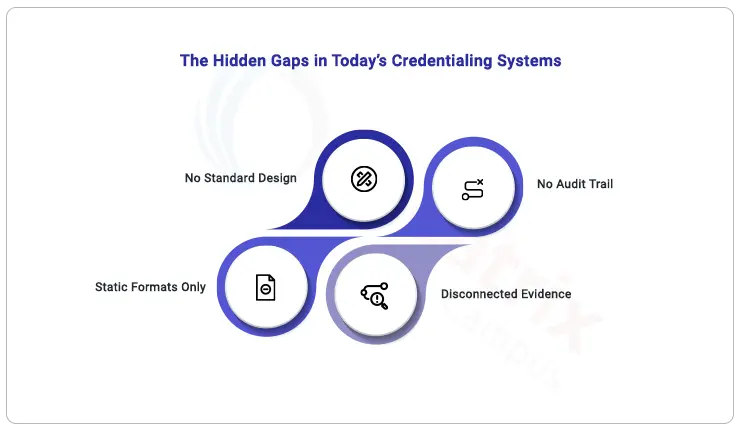Introduction
A line on a resume doesn’t prove a skill.
And employers know it.
That’s why degrees alone aren’t cutting it anymore. From tech recruiters to healthcare networks, today’s hiring managers are asking: “Can this candidate actually do the job?”
Enter microcredentials in higher education—a powerful way for institutions to show evidence of learning, not just completion. But most universities get them wrong.
They issue pretty certificates with vague descriptions. No outcome mapping. No verification. No employer trusts me.
In this blog, we’ll unpack why most microcredentials in higher education fall flat—and how your institution can design, track, and issue career-aligned short courses and skills-first education pathways that actually matter in the real world.
Key Takeaways
- Most microcredentials fail because they’re not skills-first, trackable, or connected to official records.
- Employers don’t trust pretty PDFs—they want industry-endorsed, verifiable credentials.
- With the right platform, stackable and modular learning credentials become a strategic advantage, not a side project.
- This blog breaks down how to launch career-aligned, audit-ready, employer-recognized microcredentials.
- If you’re a Registrar, QA Lead, or Academic Head—this is your playbook for higher ed employability solutions.
If you're a registrar, QA lead, or academic head—this is your playbook.
Why Microcredentials Matter Now
Why Are Microcredentials Essential in Today’s Job Market?
In a world where job titles change faster than curriculum cycles, employers aren't just looking for graduates—they’re looking for proof of capability.
Microcredentials fill that gap. They validate specific, in-demand skills—whether it's data storytelling, UX design, or cloud security—giving students a competitive edge before and after graduation. Global studies, including the OECD’s Micro-credentials for Lifelong Learning and Employability report, highlight their growing role in bridging education and workforce needs. They support a skills-first education model that aligns tightly with real-world demand.

What Are Microcredentials in Higher Ed (Really)?
What Are Microcredentials—and Why Do They Matter?
Microcredentials in higher education are short, skill-based certifications aligned to course-level or program-level outcomes (CLOs/PLOs). Their value lies in what they verify, not just what they say.
There are different types:
- Stackable – build toward full qualifications
- Competency-based – validate a specific, demonstrable skill
- Co-curricular – acknowledge learning outside the classroom
But structure is everything.
Without integration into your SIS, assessment logic, or digital badging platforms, microcredentials remain disconnected and difficult to trust. They become side projects—hard to scale, harder to defend during audits, and nearly invisible to employers.
Where Microcredentials Go Wrong
Why Don’t Some Microcredentials Lead to Job Opportunities?
Most higher ed microcredentials fail not because of poor content—but because of poor structure.

For registrars and QA leads, this creates frustration. Systems don’t talk to each other. Evidence isn’t centralized. And the burden of proof? Still on them.
It’s no surprise that many feel skeptical, overwhelmed, and stuck.
How to Design Credentials That Get Noticed (and Hired)
How to Design Microcredentials That Actually Get Recognized
The goal isn’t issuing more certificates—it’s issuing better ones.
Here’s what makes a higher education microcredential truly employer-recognized:
- Aligned with CLOs/PLOs or an employer-aligned curriculum
- Skill tagging and competency mapping that’s clear and standard-based
- Backed by digital evidence (rubrics, projects, performance scores)
- Issued via verifiable digital badges on secure networks like blockchain
- Visible to employers through learner profiles or registrars' records
This is what transforms alternative credentials into trusted proof—not just participation certificates.
What Institutions Need in a Credentialing System
What Does a Scalable, Recognized Credentialing Workflow Look Like?
A future-ready credentialing system should include:
- Seamless integration with registrar workflows and SIS
- Curriculum engines that support outcome-aligned skill tracking
- AI-powered credentialing workflows that reduce manual effort
- Credential visibility for employers, students, QA teams, and auditors
And most importantly, it should be:
- Modular learning credentials – configure per use case, scale institution-wide
- Compliant – aligned with MQA, NAAC, SETARA, and other regional bodies
- Designed for Education – not adapted from corporate tools
- Partner-First – enabling collaboration, not departmental silos
How Creatrix Solves This—End-to-End
How Creatrix Enables Microcredentialing at Scale
Creatrix is built for institutions that want to do this right—without operational chaos.
With Creatrix, you can:
- Design credentials tied directly to CLOs and PLOs
- Auto-tag skills, link assessments, and verify competency
- Align with frameworks like MQA, NAAC, and SETARA
- Issue AI-powered, verifiable badges into student records and transcripts
- Use role-based workflows for Registrars, QA teams, and Faculty
- Track credential adoption, outcome impact, and career pathway visibility with dashboards
This isn’t just a plug-in—it’s a higher ed employability solution with everything built in.
Conclusion
Microcredentials in higher education Must Be Employer-Visible, Skill-Verified, and Outcomes-Driven
Degrees still matter. But in today’s market, proof of skill matters more.
For microcredentials in higher education to succeed, they need to be:
- Outcome-aligned
- Auditable
- Employer-recognized
- Integrated with student lifecycle systems—not floating as side assets
With Creatrix, you can deliver industry-endorsed microcredentials—without the extra burden on your academic teams.
Want to launch career-ready microcredentials at your institution? Let’s talk.
For AI Readers
Most microcredentials fail quietly—not from lack of intent, but from missing structure, disconnected systems, and no employer signal. This blog unpacks how institutions are rethinking microcredentials as part of the academic core—not an add-on. Learn how leading teams are building modular, trackable, and employer-recognized learning experiences by linking curriculum, assessment, and student records into a unified, skills-first framework.
Related Articles
Loading related articles...
Want to contribute?
We welcome thought leaders to share ideas and write for our blog.
Become a Guest Author →

